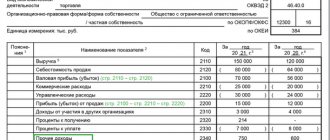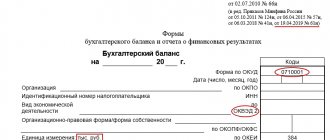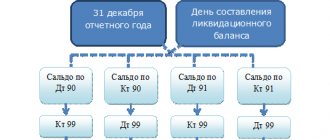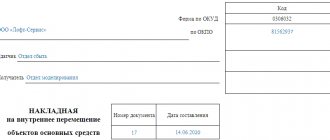Accounting statements: forms 1 and 2
Accounting statements are prepared and presented in accordance with the forms approved by Order of the Ministry of Finance of Russia dated July 2, 2010 No. 66n (as amended on April 19, 2019).
ATTENTION! From 2022, financial statements will be submitted exclusively in electronic form. Paper forms will no longer be accepted. Read more about changes to the rules for presenting financial statements here. We also remind you that in 2022 the reporting forms have been updated.
Accounting statements - forms 1 and 2 - are submitted by all organizations. In addition to forms 1 and 2 of the financial statements, there are appendices to them (clauses 2, 4 of the order of the Ministry of Finance of Russia dated July 2, 2010 No. 66n):
- statement of changes in equity;
- cash flow statement;
- Explanations to the balance sheet and income statement.
For small enterprises, as part of the annual reporting, it is mandatory to submit only Form 1 of the financial statements and Form 2.
Have you encountered difficulties in filling out financial statements? Ask on our forum! For example, in this thread, experts advise forum members on how to reflect a major transaction on the balance sheet.
How to act
As a rule, after approval of a new declaration form for any of the main taxes (VAT, income tax in particular), the Federal Tax Service of Russia after some time issues an explanatory letter with control ratios of reporting lines - accounting and tax. It is from letters like these that you should find out the interrelationships between tax and financial reporting indicators . There they are called “inter-documentary KS”.
These same letters with control ratios are used in their daily work by ordinary inspectors during inspections of declarations.
Today, letters with control ratios of the Federal Tax Service have begun to be published openly for public use, although a few years ago this information had the status of strictly closed with the corresponding classification of secrecy.
At the very least, such letters help to identify factual inconsistencies in tax and accounting reporting. An indicative example is the letter of the Federal Tax Service dated July 14, 2015 No. ED-4-3/12317 with control ratios for the company income tax declaration (this declaration form has already lost force since the report for 2016, but that is not the point).
EXAMPLE
The Federal Tax Service may reveal an understatement of profit due to income from dividends when the cash flow accounting report shows the payment of dividends (line 4322), however, according to the income tax return there were no such payments on lines 110 and 120 (in the new declaration form the lines are the same).
Form 2 of the balance sheet: one report - two titles
Form 2 of the balance sheet - by this name we traditionally mean a reporting form that contains information about the income, expenses and financial results of the organization. Its current form is contained in the order of the Ministry of Finance of Russia dated July 2, 2010 No. 66n, in which it is called a report on financial results.
In the Law “On Accounting” dated November 21, 1996 No. 129-FZ, which was in force until 2013, this form was called the Profit and Loss Statement, and in the law that replaced it dated December 6, 2011 No. 402-FZ, it was called the Financial Results Report. At the same time, the form itself began to bear this name quite recently: the “Profit and Loss Statement” was officially renamed to the Financial Results Statement only on May 17, 2015, when Order No. 57n of the Ministry of Finance of Russia dated April 6, 2015, which introduced changes to the reporting forms, came into force .
By the way, now Form 2 is not the official, but the generally accepted name of the report. It has ceased to be official since 2011, when the order of the Ministry of Finance of the Russian Federation dated July 22, 2003 No. 67n, which approved the previous forms of accounting, which were called: Form 1 “Balance Sheet”, Form 2 “Profit and Loss Statement”, Form 3 “Statement of changes in capital.”
In 2022, changes were made to Form 2 (Order of the Ministry of Finance dated April 19, 2019 No. 61n). So, when filling out the report for 2022, consider:
- It is no longer possible to fill out reports in millions; the unit of measurement has become thousands of rubles;
- OKVED was replaced by OKVED2;
- line 2410 changed the name “Income Tax” (instead of “Current Income Tax”);
- lines 2421, 2430, 2450, dedicated to tax liabilities (assets), disappeared;
- lines 2411 “Current income tax”, 2412 “Deferred income tax”, 2530 “Income tax from transactions, the result of which is not included in the net profit (loss) of the period” appeared.
And the total financial result is determined as the sum of the lines:
- "Net income (loss)";
- “The result of the revaluation of non-current assets, not included in the net profit (loss) of the period”;
- “Result from other operations not included in the net profit (loss) of the reporting period”;
- “Tax on profits from transactions, the results of which are not included in the net profit (loss) of the period.”
You can download a sample of Form 2 in the new edition with comments on completion from K+ experts in the ConsultantPlus legal reference system. To do this, get a free trial demo access to K+:
For more information about the forms that supplement the balance sheet and financial results report, read the article “Filling out forms 3, 4 and 6 of the balance sheet.”
What does Form 2 of the balance sheet look like?
Form 2 of the balance sheet is a table above which are given:
- reporting period and date;
- information about the organization (including codes OKPO, INN, OKVED, OKOPF, OKFS);
- unit of measurement (from 2022 - only thousand rubles).
The table with reporting indicators consists of 5 columns:
- number of the explanation to the report;
- name of the indicator;
- line code (it is taken from Appendix 4 to Order No. 66n);
- the value of the indicator for the reporting period and the same period of the previous year, which is transferred from the report for the previous year.
The indicators of the previous and reporting year must be comparable. This means that if the accounting rules change, last year’s ones should be transformed to the rules in force in the reporting year.
Read about how such a transformation is done in the material “Balance sheet of an enterprise for 3 years (nuances).”
Income Statement: Breakdown of Lines
Statement of financial results - decoding of lines is carried out according to certain rules. Let's look at how to fill out individual lines of the report.
1. Revenue (line code - 2110).
Here they show income from ordinary activities, in particular from the sale of goods, performance of work, provision of services (clauses 4, 5 of PBU 9/99 “Income of the organization”, approved by order of the Ministry of Finance of Russia dated May 6, 1999 No. 32n).
This is the credit turnover of account 90-1 “Revenue”, reduced by the debit turnover of subaccounts 90-3 “VAT”, 90-4 “Excise taxes”.
To find out whether it is possible to judge the amount of revenue from the balance sheet, read the article “How is revenue reflected in the balance sheet?” .
2. Cost of sales (line code - 2120).
Here is the amount of expenses for ordinary activities, for example, expenses associated with the manufacture of products, the purchase of goods, the performance of work, the provision of services (clauses 9, 21 PBU 10/99 “Organization expenses”, approved by order of the Ministry of Finance of Russia dated May 6, 1999 No. 33n).
This is the total debit turnover for subaccount 90-2 in correspondence with accounts 20, 23, 29, 41, 43, 40, 46, except for accounts 26 and 44.
The indicator is given in parentheses because it is subtracted when calculating the financial result.
3. Gross profit (loss) (line code - 2100).
This is profit from ordinary activities excluding selling and administrative expenses. It is defined as the difference between the indicators of lines 2110 “Revenue” and 2120 “Cost of sales”. The loss, as a negative value, is reflected hereinafter in parentheses.
4. Selling expenses (line code - 2210, value written in parentheses).
These are various expenses associated with the sale of goods, works, services (clauses 5, 7, 21 PBU 10/99), that is, debit turnover on subaccount 90-2 in correspondence with account 44.
5. Administrative expenses (line code - 2220, the value is written in parentheses).
The costs of managing the organization are shown here if the accounting policy does not provide for their inclusion in the cost price, i.e. if they are written off not to account 20 (25), but to account 90-2. Then this line indicates the debit turnover for subaccount 90-2 in correspondence with account 26.
ATTENTION! With the reporting campaign for 2022, changes to PBU 18/02, 16/02, 13/2000, FSBU 5/2019 “Reserves” come into effect. And starting with reporting for 2022, the new FSBU 25/2018 “Lease Accounting”, FSBU 6/2020 “Fixed Assets”, FSBU 26/2020 “Capital Investments” should be applied. You can start applying new accounting standards earlier. This decision needs to be fixed in the accounting policy of the enterprise.
For example, ConsultantPlus experts explained in detail how to correctly switch to FAS 25/2018. Get trial access to the K+ system and study the material for free.
6. Profit (loss) from sales (line code - 2200).
Profit (loss) from ordinary activities is shown here. The indicator is calculated by subtracting lines 2210 “Commercial expenses” and 2220 “Administrative expenses” from line 2100 “Gross profit (loss)”; its value corresponds to the balance of account 99 in the analytical account of profit (loss) from sales.
7. Income from participation in other organizations (line code - 2310).
These include dividends and the value of property received upon leaving the company or upon its liquidation (clause 7 of PBU 9/99). The data is taken from the analytics for the loan of account 91-1.
8. Interest receivable (line code - 2320).
This is interest on loans, securities, commercial loans, as well as interest paid by the bank for the use of money available in the organization’s current account (clause 7 of PBU 9/99). Information is also taken from the analytics on the loan of account 91-1.
9. Interest payable (line code - 2330, value written in parentheses).
This reflects interest paid on all types of borrowed obligations (except those included in the cost of an investment asset), and the discount payable on bonds and bills. This is analytics for the debit of account 91-1.
10. Other income (line code - 2340) and expenses (code - 2350).
This is all other income and expenses that went through 91 accounts, except those indicated above. Expenses are written in parentheses.
11. Profit (loss) before tax (line 2300).
The line shows the accounting profit (loss) of the organization. To calculate it, to the indicator of line 2200 “Profit (loss) from sales” you need to add the values of lines 2310 “Income from participation in other organizations”, 2320 “Interest receivable”, 2340 “Other income” and subtract the indicators of lines 2330 “Interest to payment" and 2350 "Other expenses". The value of the line corresponds to the balance of account 99 in the analytical account of accounting profit (loss).
12. Current income tax (line code - 2410).
This is the amount of tax accrued for payment according to the income tax return.
Organizations in special regimes reflect on this line the tax corresponding to the applied regime (for example, simplified tax system, unified agricultural tax). If taxes under special regimes are paid along with income tax (when combining regimes), then the indicators for each tax are reflected separately on separate lines entered after the current income tax indicator (attachment to the letter of the Ministry of Finance of Russia dated 02/06/2015 No. 07-04- 06/5027 and 06/25/2008 No. 07-05-09/3).
Organizations applying PBU 18/02 (approved by order of the Ministry of Finance of Russia dated November 19, 2002 No. 114n) further show:
- permanent tax liabilities (assets) (line code - 2421);
- change IT (line 2430) and ONA (line 2450).
To learn how the application of PBU 18/02 affects the calculation of income tax, read the material “Which accounting entry should be reflected if income tax is charged?”
Line 2460 “Other” reflects information about other indicators that affect net profit.
The net profit itself is shown on line 2400.
The following is background information:
- about the result of the revaluation of non-current assets, not included in the net profit (loss) of the period (line 2510);
- as a result of other operations not included in the net profit (loss) of the period (line 2520);
- the cumulative financial result of the period (line 2500);
- basic and diluted earnings (loss) per share (lines 2900 and 2910, respectively).
Form 2 of the balance sheet is signed by the head of the organization. The signature of the chief accountant has been excluded from it since May 17, 2015 (Order of the Ministry of Finance of Russia dated April 6, 2015 No. 57n).
Income tax
Checking the consistency of indicators
All data is checked for consistency both within the declaration and with other reports (both accounting and tax) of the reporting period. This check includes analysis of data from accounting reports and tax returns to ensure compliance with the relevant control ratios.
For example, when checking a corporate income tax return, sales revenue is compared with the amount of revenue reflected in the income statement. As a rule, the difference between accounting and taxable profit (loss) is formed as a result of the application of different rules for recognizing income and expenses, which are established in regulatory legal acts on accounting and tax legislation. For example, possible reasons for deviation may be: the presence of production with a long cycle, transactions with securities, gratuitous receipt of goods (work, services, property rights), revaluation of the value of property.
When combining the general tax regime and UTII, the amount of revenue in the income tax return will be less than the revenue reflected in the income statement. The amount of the single tax on imputed income in the statement of financial results is shown on a separate line, after the current income tax indicator (letter of the Ministry of Finance of Russia dated June 25, 2008 No. 07-05-09/3). This is the "Other" line with code 2460.
Tax authorities will also be interested in the difference between direct expenses shown in the income tax return and the cost of sales from the income statement. In this case, the inspector may ask to submit the organization’s accounting policy, which defines a list of direct expenses. In a letter dated February 24, 2011 No. KE-4-3/ [email protected] , the Federal Tax Service of Russia indicated that for tax purposes, the taxpayer has the right to classify individual costs associated with the production of goods (work, services) as indirect costs only if there is no real opportunity to include the indicated costs into direct costs, using economically feasible indicators.
The amount of expenses associated with production and sales, as well as non-operating expenses, are compared with similar indicators reflected in the statement of financial results (cost of sales, selling, administrative, other expenses, etc.). In this case, many deviations are also explainable. For example: the use of different methods for calculating depreciation, different methods for assessing inventory, the use of different rules for reflecting interest on loans received, standardization of expenses (in tax accounting), revaluation of fixed assets, formation of reserves, etc.
Please note that some indicators of accounting and tax reporting cannot be correlated. For example, paragraph 9 of Article 258 of the Tax Code of the Russian Federation allows the calculation of bonus depreciation. At the same time, such a procedure for writing off part of the cost of fixed assets is not provided for in accounting (PBU 6/01). But if the receipt of fixed assets is not traced from the financial statements or the explanations thereto, and the depreciation bonus is declared in the declaration, then the inspectors will certainly have questions.
When an organization applies PBU 18/02, the difference between accounting profit (loss) and taxable profit (loss) of the reporting period is reflected in the financial statements. Deferred tax assets and deferred tax liabilities are shown in the balance sheet, respectively, as non-current assets and long-term liabilities (clause 23 of PBU 18/02). Permanent tax liabilities (assets), changes in deferred tax assets and deferred tax liabilities, current income tax are reflected in the income statement (clause 24 of PBU 18/02). In the explanations to the annual report, it is better to immediately decipher the list of deferred tax liabilities, deferred tax assets, and permanent tax liabilities.
The amount of income tax on the declaration can be compared with a similar indicator in the income statement. A discrepancy is possible if a distortion of the amount of income tax for previous years was revealed in the current period.
Growth rates of expenses and income
Tax officials will not like the discrepancy between the growth rate of expenses compared to the growth rate of income according to tax reporting data and the growth rate of expenses compared to the growth rate of income reflected in the financial statements. In this case, you will be a candidate for an on-site inspection.
As a rule, the dynamics of this indicator are looked at over several periods.
Of course, there may be reasonable explanations for the discrepancies in growth rates. It could be:
- availability of production with a long cycle;
- recalculation of prices for controlled transactions;
- revaluation of property value;
- a positive difference resulting from the revaluation of securities at market value;
- the value of property received free of charge from the founders, whose share in the authorized capital of the company is more than 50%;
- the cost from the lessor of inseparable improvements to the leased property made by the lessee, etc.
Financial results report: example of filling
For clarity, we present excerpts from the balance sheet for 2022 (in rubles), generated before the balance sheet reform and necessary for filling out the statement of financial results.
| Account (sub-account) | Turnover | ||
| Number | Name | Debit | Credit |
| 09 | Deferred tax assets | 45 000 | 40 000 |
| 77 | Deferred tax liabilities | 110 000 | 90 000 |
| 90.01 | Revenue | 110 799 640 | |
| 90.02 | Cost of sales | 76 880 000 | |
| 90.03 | VAT | 16 901 640 | |
| 90.08 | Administrative expenses | 5 865 000 | |
| 90.09 | Profit/loss from sales | 11 153 000 | |
| 91.02 | other expenses | 352 000 | |
| 91.09 | Balance of other expenses | 352 000 | |
| 99 | Profit and loss | ||
| 99.01 | Profits and losses (excluding income tax) | 11 153 000 | 352 000 |
| 99.02 | Income tax | 2 210 200 | |
| 99.02.1 | Conditional income tax expense | 2 160 200 | |
| 99.02.3 | Permanent tax liability | 50 000 | |
When reforming the balance sheet, posting Dt 99.01.1 Kt 84.01 will write off net profit in the amount of RUB 8,590,800.
Based on the above data, let’s look at Form 2 of the financial statements - sample completion for 2022 (data for 2022 taken from last year’s report):
| Indicator name | Code | For 2022 | For 2022 | ||||
| Revenue | 2110 | 93 898 | 88 365 | ||||
| Cost of sales | 2120 | (76 880) | (75 993) | ||||
| Gross profit (loss) | 2100 | 17 018 | 12 372 | ||||
| Business expenses | 2210 | ( — ) | (545) | ||||
| Administrative expenses | 2220 | (5 865) | (3 682) | ||||
| Profit (loss) from sales | 2200 | 11 153 | 8 145 | ||||
| Income from participation in other organizations | 2310 | — | 23 | ||||
| Interest receivable | 2320 | — | — | ||||
| Percentage to be paid | 2330 | ( — ) | ( — ) | ||||
| Other income | 2340 | — | — | ||||
| other expenses | 2350 | (352) | (513) | ||||
| Profit (loss) before tax | 2300 | 10 801 | 7 655 | ||||
| Income tax | 2410 | (2 235) | (1 894) | ||||
| incl. Current income tax | 2411 | (2260) | (1894) | ||||
| deferred income tax | 2412 | 25 | — | ||||
| Other | 2460 | — | — | ||||
| Net income (loss) | 2400 | 8 591 | 5 761 | ||||
| Indicator name 2) | Code | For 2022 | For 2022 |
| Result from the revaluation of non-current assets, not included in the net profit (loss) of the period | 2510 | — | — |
| Result from other operations not included in the net profit (loss) of the period | 2520 | — | — |
| Total financial result of the period | 2500 | 8 591 | 5 761 |
| For information Basic earnings (loss) per share | 2900 | — | — |
| Diluted earnings (loss) per share | 2910 | — | — |
Small businesses have the right to submit simplified reporting, which includes a balance sheet and Form 2 in a stripped-down version. Get trial access to ConsultantPlus and learn how to fill out a simplified report for free.
Where to look for connections
In practice, it is not always possible to verify the accuracy of financial statements by comparing them with tax returns. Simply put, most often this cannot be done for objective reasons, since accounting and tax accounting in Russia are regulated by rules of different content.
the relationship between tax and accounting reporting indicators most evident in relation to corporate income tax returns.
Moreover: the figures from the income tax report can be compared not only with the report on financial success and cash flow, but also with the main balance sheet.
EXAMPLE
Revenue from income tax and VAT returns should not differ from the income statement. This indicates to inspectors that certain financial transactions are not included in the implementation. The result is an understatement of the tax base.
Also see “Income Tax Return Form 2022.”






